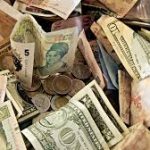 If anyone is going to be in or around Washington DC on April 20, the National Press Club is holding a conference on the future of currencies and foreign exchange rates. The Project on Exchange Rates and the Dollar is hosted by former Congressman Jack Kemp and Steven Hanke, a John Hopkins University Professor who tends to have a very good read on the future direction of the Chinese yuan.
If anyone is going to be in or around Washington DC on April 20, the National Press Club is holding a conference on the future of currencies and foreign exchange rates. The Project on Exchange Rates and the Dollar is hosted by former Congressman Jack Kemp and Steven Hanke, a John Hopkins University Professor who tends to have a very good read on the future direction of the Chinese yuan.
The conference is a bit wonkish, but features IMF and Agricultural Bank of China economists (that’s one of China’s Big Four), as well as House Speaker Paul Ryan and former chairman of the Federal Reserve Paul Volcker.
The topic is about whether or not the post-2008 crisis world needs a new Plaza Accord. The original accord put an end to floating exchange rates and was signed at the Plaza Hotel back in 1985. The idea today is to promote something similar, doing away with so-called “currency wars” that impacts trade. A free-floating peso for example would basically offset any new tax regime in the U.S., and render a NAFTA rewrite moot because the value of the peso would become so low that it would compensate for the new duties. In other words, Kemp and company see currency as a way to distort trade.
For investors who love a good yarn on the political struggle between the dollar and gold, this discussion may be for you.
During the last decade, the world has been wracked by large exchange rate swings between the U.S. dollar and the euro, the two largest world currencies, the Kemp Foundation writes. China is now considering breaking its currency link to the dollar and letting it go free float, though this is likely to take years. Nevertheless, exchange rate instability often causes asset bubbles and unstable capital flows that can lead to dangerous speculative capital flow. It’s fun while it’s flowing in the right direction. But when it goes the other way, all hell breaks loose.
The conference’s purpose, ahead of the IMF spring meeting, is to focus national and international attention on the need for a more coordinated and stable exchange rate regime among the Big Three currencies.
Details can be found here.

